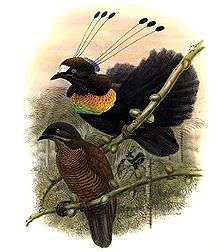Parotia
| Parotias | |
|---|---|
 | |
| Lawes's parotia, Parotia lawesii Male above, female below | |
| Scientific classification | |
| Kingdom: | Animalia |
| Phylum: | Chordata |
| Class: | Aves |
| Order: | Passeriformes |
| Family: | Paradisaeidae |
| Genus: | Parotia Vieillot, 1816 |
| Species | |
|
6; see text | |
The parotias are a genus, Parotia, of passerine birds in the bird-of-paradise family Paradisaeidae. They are found on New Guinea, to which they are endemic. They are also known as six-plumed birds of paradise, due to their six head quills. These birds were featured prominently in the BBC series Planet Earth.
The males of the genus are characterized by an ornamental plumage consisting of six wired head plumes with black oval-shaped tips, a neck collar of black, decomposed feathers which can be spread into a skirt-like shape, and bright or iridescent head and throat markings. During courtship, they perform ballerina-like dances and spread out their "skirt" on a patch of forest floor they have meticulously cleaned of dead leaves and other debris.[1] The "ballerina dances" usually consist of the male hopping from foot and bobbing their heads from side to side. The males are polygamous and do not take part in raising the young. Clutch size is somewhat uncertain; it is usually one to three eggs.[2]
Species
- Western parotia, Parotia sefilata
- Queen Carola's parotia, Parotia carolae
- Bronze parotia, Parotia berlepschi
- Lawes's parotia, Parotia lawesii
- Eastern parotia, Parotia helenae
- Wahnes's parotia, Parotia wahnesi
References
| Wikimedia Commons has media related to Parotia. |
| Wikispecies has information related to: Parotia |
- Mackay, Margaret D. (1990): The Egg of Wahnes' Parotia Parotia wahnesi (Paradisaeidae). Emu 90(4): 269.
- Scholes III, Edwin (2008): Evolution of the courtship phenotype in the bird of paradise genus Parotia (Aves: Paradisaeidae): homology, phylogeny, and modularity. Biological Journal of the Linnean Society 94: 491–504.